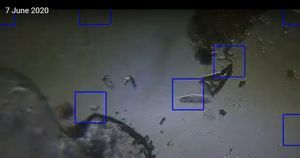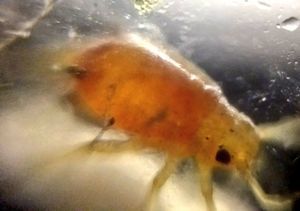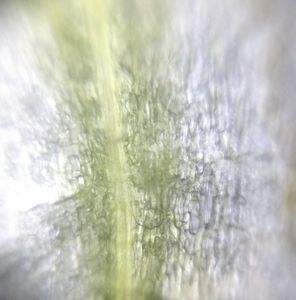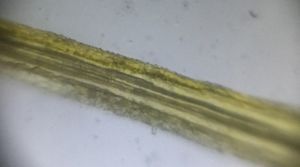Motion detection in Foldscope videos using Python and OpenCV
 Jul 07, 2020 • 3:20 AM UTC
Jul 07, 2020 • 3:20 AM UTC Unknown Location
Unknown Location 140x Magnification
140x Magnification Microorganisms
Microorganisms
ashpat
I am a software architect currently working on creating enterprise scale IoT application. I also love to work on python and machine learning.
12posts
3comments
1locations


There are three types of organisms one can see in above video, the round one, the long one and couple of amoeba Last year, I was introduced to a wonderful scientific instrument called the ‘Foldscope’. I have spent hours observing things with it. One of my favorite past times is to observe ciliates using the Foldscope. Ciliates are very simple single cell organisms which are easy to find and come in numerous shapes and sizes. Most ciliates move very fast, and you need some skill with a microscope to follow them on the slide. This inspired me to write some code that could detect moving objects in a video and draw rectangles around them. Amazingly, I believe I was able to do a decent job with under 60 lines of python code ( https://github.com/code2k13/motiondetection )
In this post I will discuss concepts which I used for detecting moving objects and how the work together to come up with the end results.
Reading videos with Python and OpenCV The first thing we need to be able to do is load frames one by one from a video. OpenCV makes this task very easy. OpenCV has a very convenient function called ‘ cv2.VideoCapture ’ which returns an object that can be used to find out information about the video (like width, height, frame rate). The same object allows us to read a single frame from the video by calling ‘ read() ’ method on it. The ‘ read() ’ method returns two values, a boolean indicating success of the operation and the frame as an image.
cap = cv2.VideoCapture("video_input.mp4")
if cap.isOpened():
width = cap.get(3) # float
height = cap.get(4) # float
fps = cap.get(cv2.CAP_PROP_FPS) The full video can be read frame by frame using following code:
success = True
while success:
success,frame = cap.read()
if not success:
break
#do something with the frame Writing videos using OpenCV Writing videos with OpenCV is also very easy. Similar to ‘ VideoCapture ’ function, the ‘ VideoWriter ’ function can be used to write video , frame by frame. This function expects path of output video, codec information, frames per second, width and height of output video as parameters.
fourcc = cv2.VideoWriter_fourcc('m','p','4','v')
out = cv2.VideoWriter('video_output.mp4',fourcc , int(fps), (int(width),int(height))) Writing a frame to the video is as easy as calling:
out.write(image_obj) Finding frame difference
In this post I will discuss concepts which I used for detecting moving objects and how the work together to come up with the end results.
Reading videos with Python and OpenCV The first thing we need to be able to do is load frames one by one from a video. OpenCV makes this task very easy. OpenCV has a very convenient function called ‘ cv2.VideoCapture ’ which returns an object that can be used to find out information about the video (like width, height, frame rate). The same object allows us to read a single frame from the video by calling ‘ read() ’ method on it. The ‘ read() ’ method returns two values, a boolean indicating success of the operation and the frame as an image.
cap = cv2.VideoCapture("video_input.mp4")
if cap.isOpened():
width = cap.get(3) # float
height = cap.get(4) # float
fps = cap.get(cv2.CAP_PROP_FPS) The full video can be read frame by frame using following code:
success = True
while success:
success,frame = cap.read()
if not success:
break
#do something with the frame Writing videos using OpenCV Writing videos with OpenCV is also very easy. Similar to ‘ VideoCapture ’ function, the ‘ VideoWriter ’ function can be used to write video , frame by frame. This function expects path of output video, codec information, frames per second, width and height of output video as parameters.
fourcc = cv2.VideoWriter_fourcc('m','p','4','v')
out = cv2.VideoWriter('video_output.mp4',fourcc , int(fps), (int(width),int(height))) Writing a frame to the video is as easy as calling:
out.write(image_obj) Finding frame difference
The above video was generated out of frame diffs from the original video Images are represented as matrices in the memory. OpenCV has a function called ‘ cv2.absdiff() ’ which can be used to calculated absolute difference of two images. This is the basis of our motion detection. We are relying on the fact that when something in the video moves ‘ absdiff ‘ will be non zero for those pixels. However if something is stationary and has not moved in two consequent frames, the absdiff will be zero. So, as we read the video frame by frame, we compare current frame with older frame and calculate absdiff matrix.
Sounds easy , right ? But there are some problems with this approach. Firstly, cameras and software produce artifacts when they capture and encode videos. Such artifacts give us non-zero diff even when the object is stationary . Uneven lighting and focusing can also cause non-zero diffs for stationary portions of videos.
After experimenting with some approaches, I found out that thresholding the diff image using mean values works very well to eliminate such ‘noise’
frame_diff[frame_diff < frame_diff[np.nonzero(frame_diff)].mean()] = 0
frame_diff[frame_diff > frame_diff[np.nonzero(frame_diff)].mean()] Using edge detection to improve accuracy
Sounds easy , right ? But there are some problems with this approach. Firstly, cameras and software produce artifacts when they capture and encode videos. Such artifacts give us non-zero diff even when the object is stationary . Uneven lighting and focusing can also cause non-zero diffs for stationary portions of videos.
After experimenting with some approaches, I found out that thresholding the diff image using mean values works very well to eliminate such ‘noise’
frame_diff[frame_diff < frame_diff[np.nonzero(frame_diff)].mean()] = 0
frame_diff[frame_diff > frame_diff[np.nonzero(frame_diff)].mean()] Using edge detection to improve accuracy
Edge detection using ‘Sobel’ filter performed on the frame diff video As microorganisms move, they push matter around them, which gives positive pixels after diff-ing. But we want to differentiate micro-organisms from other things. Also focusing plays an important part here. Generally a lot of out of focus moving objects will also give positive frame differences. Mostly these are blurred objects which we simply want to ignore. This is where edge detection comes into play, to find edges and borders in the image. This can be easily achieved by using ‘Sobel ‘ filter from scikitlearn package.
from skimage import filters
output = filters.sobel(frame_diff) Using contour detection to detect objects
from skimage import filters
output = filters.sobel(frame_diff) Using contour detection to detect objects
Video generated after performing contour detection on the Sobel filter output
Most protozoans like ciliates will not always show a clear border (because they are mostly transparent). So when we use edge detection to detect shapes/outlines of moving objects, we get broken edges. In my experience contour detection works very well to group such broken edges and generate a more continuous border.
contours, hierarchy = cv2.findContours(thresh,cv2.RETR_TREE,cv2.CHAIN_APPROX_SIMPLE) OpenCV has built-in functions to find contours. The best part is, the function is able to find nested contour structures and return a hierarchy. The ‘ cv2.findCountours ‘ function returns a hierarchy of contours. We only consider top level contours (who don’t have a parent). If, for a contour ‘ idx ‘ , ‘ hierarchy[0][idx][3] ‘ returns -1, it means that it is a top level contour and it does not have any parent. Everything else we ignore.
Drawing bounding boxes around objects
Most protozoans like ciliates will not always show a clear border (because they are mostly transparent). So when we use edge detection to detect shapes/outlines of moving objects, we get broken edges. In my experience contour detection works very well to group such broken edges and generate a more continuous border.
contours, hierarchy = cv2.findContours(thresh,cv2.RETR_TREE,cv2.CHAIN_APPROX_SIMPLE) OpenCV has built-in functions to find contours. The best part is, the function is able to find nested contour structures and return a hierarchy. The ‘ cv2.findCountours ‘ function returns a hierarchy of contours. We only consider top level contours (who don’t have a parent). If, for a contour ‘ idx ‘ , ‘ hierarchy[0][idx][3] ‘ returns -1, it means that it is a top level contour and it does not have any parent. Everything else we ignore.
Drawing bounding boxes around objects
Video showing bounding boxes drawn over contours Creating boxes around contours can require a bit of math. Luckily OpenCV has a convenient function ‘ cv2.boundingRect ‘ which returns center coordinates, width and height of bounding rectangle around a given contour. Once we have that, a rectangle on our frame can simply be drawn using cv2.rectangle function. We can pass the color and border-width when drawing the rectangle to this function.
if hierarchy[0][idx][3]== -1 :
x,y,w,h = cv2.boundingRect(contour)
if (w*h <= (q)**2):
continue
image = cv2.rectangle(image, (x,y),(x+w,y+h), color, 1) The concept of ‘q’ Like I explained earlier, videos taken using a microscope can be messy. There can be a lot going on. We may be only interested in detecting objects of a certain size. This is where I have introduced a parameter called ‘q’. This parameter was used for altering settings for various filters I experimented with. Currently this is only used to filter out bounding rects which are smaller than q^2 in area. You should experiment with different values of ‘q’ , depending on the resolution of your video and size of objects you are interested in.
Things to improve I want to make this approach fast enough so that it can run in real time. Also it would be nice if I can get this ported to a mobile phone. I also plan to experiment with ML based segmentation techniques for better detection.
Full code The full code , along with sample video is available on GitHub:
https://github.com/code2k13/motiondetection
if hierarchy[0][idx][3]== -1 :
x,y,w,h = cv2.boundingRect(contour)
if (w*h <= (q)**2):
continue
image = cv2.rectangle(image, (x,y),(x+w,y+h), color, 1) The concept of ‘q’ Like I explained earlier, videos taken using a microscope can be messy. There can be a lot going on. We may be only interested in detecting objects of a certain size. This is where I have introduced a parameter called ‘q’. This parameter was used for altering settings for various filters I experimented with. Currently this is only used to filter out bounding rects which are smaller than q^2 in area. You should experiment with different values of ‘q’ , depending on the resolution of your video and size of objects you are interested in.
Things to improve I want to make this approach fast enough so that it can run in real time. Also it would be nice if I can get this ported to a mobile phone. I also plan to experiment with ML based segmentation techniques for better detection.
Full code The full code , along with sample video is available on GitHub:
https://github.com/code2k13/motiondetection
Sign in to commentNobody has commented yet... Share your thoughts with the author and start the discussion!

 0 Applause
0 Applause 0 Comments
0 Comments








